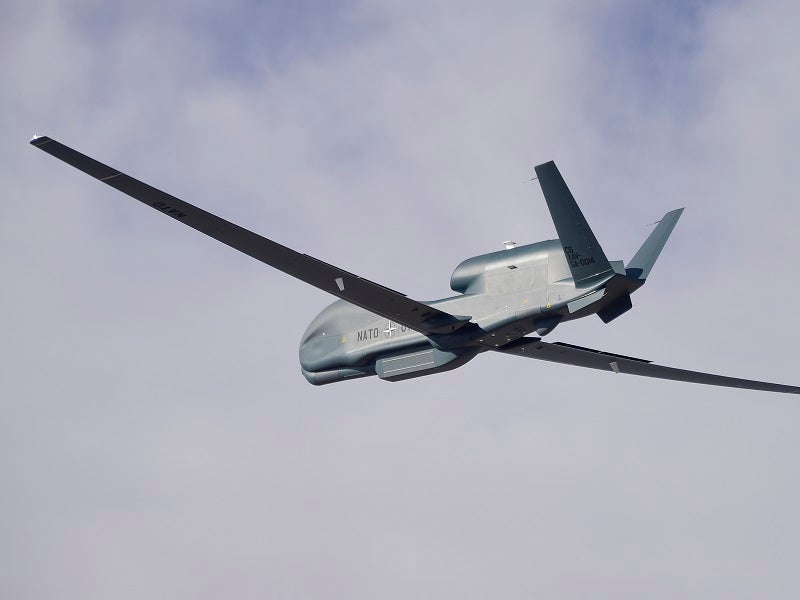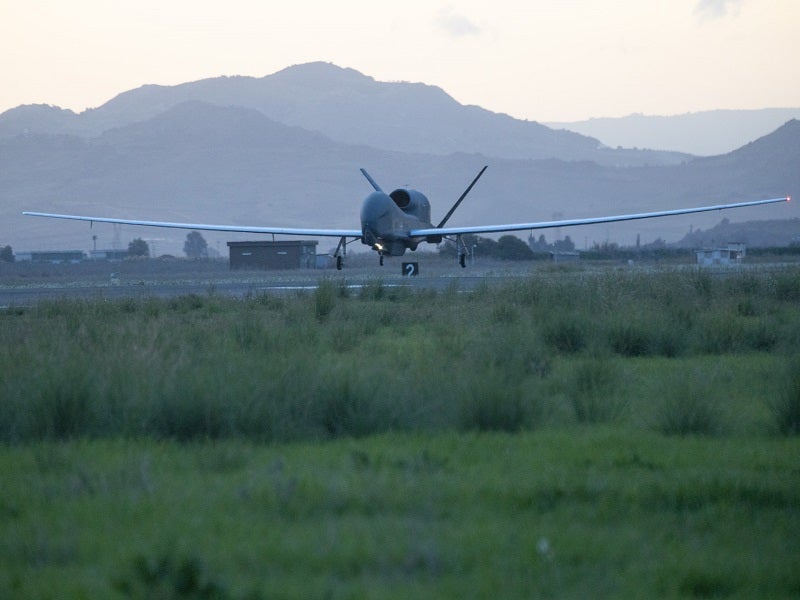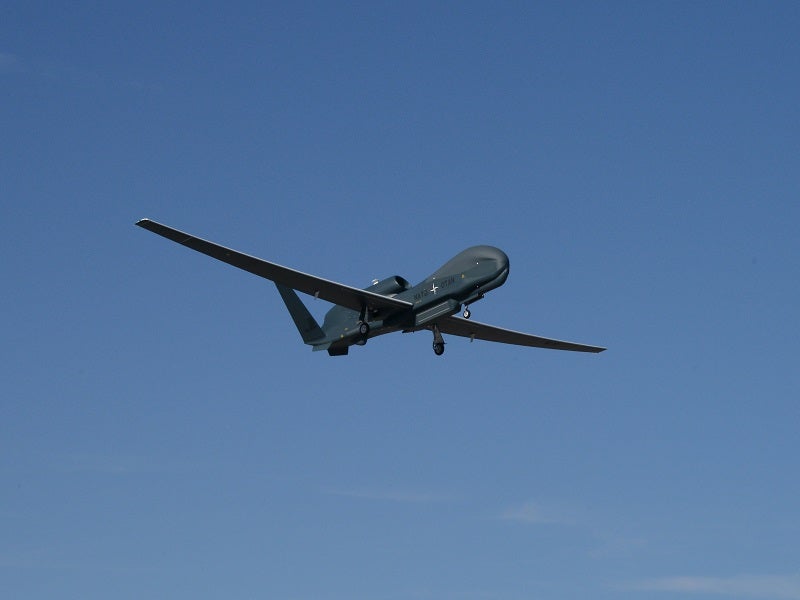RQ-4D Phoenix is a high-altitude, long-endurance (HALE) unmanned aircraft system (UAS) designed by Northrop Grumman for NATO’s Alliance Ground Surveillance (AGS) programme, which provides an airborne ground surveillance capability for NATO member states.
The UAS provides a full spectrum of intelligence, surveillance and reconnaissance (ISR) operations for NATO. The AGS system comprises a total of five RQ-4D Phoenix UASs based at Sigonella Air Base in Italy.
The NATO AGS Force, which was activated in 2015, operates the RQ-4D remotely piloted aircraft.
RQ-4D Phoenix development details
NATO Alliance Ground Surveillance Management Agency (NAGSMA) and Northrop Grumman Integrated System Sector International (NGISSII) signed the authorisation to proceed (ATP) for the AGS core contract in March 2012.
NATO nations signed a contract to procure the AGS system at the NATO summit in Chicago, US, in May 2012. The programme involves 15 NATO nations, including the Czech Republic, Denmark, Bulgaria, Germany, Italy, Latvia, Estonia, Luxembourg, Norway, Lithuania, Poland, Romania, Slovakia, Slovenia and the US.
The fuselage of the first aircraft was completed at Northrop Grumman’s Moss Point facility in July 2.14 in Mississippi, US, while the second aircraft’s fuselage was completed in November 2014.
The first live ground test of the RQ-4D Phoenix aircraft was carried out in September 2015.
NAGSMA awarded a framework contract to Airbus to provide initial in-service support services for the project in January 2019. The contractual scope includes the supply of spare parts and the provision of sustainment services for mobile general ground station (MGGS) units.
The first RQ-4D aircraft landed in Sigonella, Italy, in November 2019, followed by the second in December 2019. The fourth and fifth landed in July 2020. The fifth and final AGS aircraft landed in Sigonella in November 2020.
NATO’s Alliance Ground Surveillance Management Organization (NAGSMO) officially transferred the ownership and responsibilities of the AGS programme’s second mission operations support element to AGS Support Partnership Committee (SPC) in January 2021.
The RQ-4D Phoenix achieved initial operating capability in February 2021. The handover of the AGS system to the NATO AGS Force was started in November 2020 and completed in March 2022.
Following the handover, the NATO Support and Procurement Agency (NSPA) assumed responsibility for the programme management and through-life support.
A $13m contract was awarded to Northrop Grumman in September 2022 to develop, implement and test radar technology insertion programme (RTIP) sensors for NATO at the Sigonella base.
The contractual scope also includes integrated mission management computer maintenance and repair.
The contract involves sales to NATO under the Foreign Military Sales (FMS) programme and is expected to be completed by September 2023.
RD-4D Phoenix technical specifications
The RQ-4D is a modified version of the US Air Force’s (USAF) RQ-4 Block 40 Global Hawk. The modifications were executed to meet the specific requirements of the NATO AGS Force.
The UAS has a length of 47.6ft (14.5m), a height of 15.3ft (4.7m), a wingspan of 130.9ft (39.8m) and a gross weight of 14,950lb (6,781kg).
The maximum take-off weight of the aircraft is 32,250lb (14,628kg) while the maximum payload carrying capacity is 3,000lb (1,360kg).
The RQ-4D Phoenix provides a range of 8,700nm (16,113km).
Sensors onboard RQ-4D Phoenix UAS
The unmanned aircraft features a ground surveillance radar developed under the USAF’s multi-platform radar technology insertion programme (MP-RTIP), a radar systems improvement effort led by Northrop Grumman.
An extensive suite of long-range, wideband data links is also fitted for line-of-sight (LOS) and beyond-line-of-sight (BLOS) communications between ground and air segments.
RQ-4D Phoenix engine and performance
The powerplant used in the remotely piloted aircraft features Rolls-Royce North America’s AE 3007H turbofan engine, which has a fuel capacity of 17,300lb (7,847kg) and provides a maximum thrust of 7,600lb.
The UAS can attain a maximum speed of 310kt (575km/h) and fly at a maximum altitude of 60,000ft (18,288m).
AGS system details
The AGS core features a combination of ground, air and mission support segments that provide near-real-time, persistent wide-area terrestrial and maritime surveillance in all weather conditions during day and night. It also incorporates advanced sensor technologies.
The system provides comprehensive situation awareness to the commanders of deployed forces. It supports NATO members in various missions, including the protection of ground troops and civilian populations, anti-terrorism operations, border control and maritime safety, and humanitarian assistance operations during natural disasters.
The air segment comprises five RQ-4D Phoenix unmanned aerial vehicles (UAVs) and flight control stations (AVMC2). The ground segment provides an interface for interoperability between the AGS core system and command, control, intelligence, surveillance and reconnaissance (C2ISR) systems.
Equipped with multiple mobile and transportable ground stations built by Airbus, the ground segment enables datalink connectivity, as well as data processing and exploitation capabilities. The industry team led by Northrop Grumman also includes Airbus, Leonardo and Kongsberg.
The surveillance capabilities provided by the AGS programme are complemented by interoperable contributions such as national surveillance systems and data/communications support from member countries.
Software upgrade to RQ-4D
NATO’s first RQ-4D aircraft underwent the Maritime Mode software upgrade and returned to the Sigonella Air Base in September 2022.
The manufacturer performed the upgrade and equipped the UAS with the Maritime Mode, which enhances ISR capabilities.
The remaining four UAVs will undergo the upgrade at the NAGSF main operating base.
The Maritime Mode provides enhanced capabilities to detect and monitor moving vessels. The maritime inverse synthetic aperture radar (MISAR) component of the Maritime Mode enables the aircraft to identify non-cooperative targets.
The moving target indicator and MISAR provide ISR information on vessels moving on the surface of the water.






